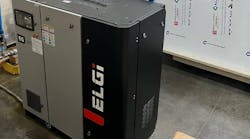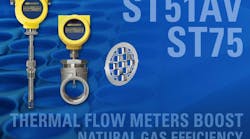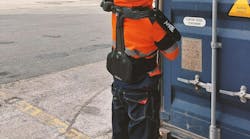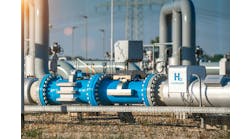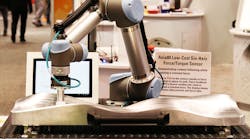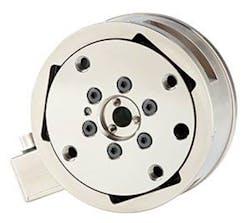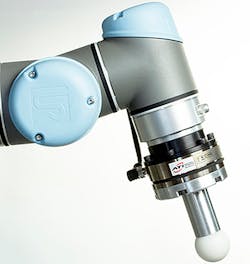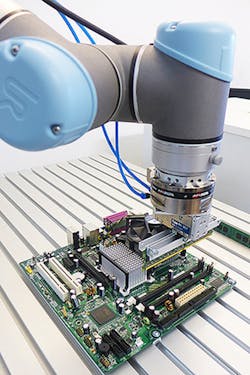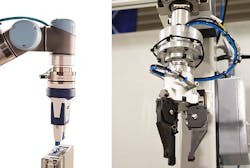Today’s robots have a wide range of applications, from the seemingly simple to the more dangerous and technical. The industry's propulsion of them isn't slowing down anytime soon either, as they offer endless possibilities for keeping costs down and workers safe.
Because of this, researchers have been developing and introducing more object-sensing capabilities to robots so tasks are completed with a higher level of precision. A force/torque (FT) sensor is one such device that allows robots to be able to feel forces exerted in all directions, making it an integral part in robotics.
To get a more in-depth look on just how advantageous and beneficial these sensors are for the industry, NED spoke with ATI Industrial Automation’s product manager of Force/Torque Sensors, Ian Stern.
NED: What is the importance of force sensors in the industry and how are they helping to move automation forward?
Force/Torque sensors provide robots the ability to feel the process that they are performing. This sense of touch can be used for tasks as simple as detecting when a part has been pushed up against a guide rail in a punch press application, or in extremely dexterous applications such as buffing the perfect shine on a hand-built concert grand piano. The ability of robots to sense their surroundings allows them to adapt their processes in applications with multiple complex variables. Force/Torque sensor technology refines automated processes to produce higher quality results.
NED: How have force sensors already been traditionally used in manufacturing?
Over the 29 years that ATI has been selling F/T Sensors, we have seen a wide variety of different applications. Although, the industry-at-large is just beginning to implement these applications in more significant numbers.
NED: What “everyday tasks” do you believe the technology could help automate?
Grinding, sanding, and polishing are tasks that are traditionally performed by people. Humans have a refined sense of touch and are really good at applying constant, even forces. Unfortunately, those material removal jobs are repetitive, dirty, and hard on the body. People also excel in high-precision assembly tasks such as installing delicate electrical connectors, meshing gears together in a transmission, or positioning components that have very tight tolerances. While not as dangerous, these are monotonous jobs.
NED: How have those tasks traditionally been completed?
It is true that some material removal and assembly tasks are uniquely suited to human strengths, but the jobs often involve long shifts with repetitive movement in less than ideal conditions. Automating these tasks with force/sensing technology enables a greater degree of process control and allows human workers to apply critical thinking skills in safer jobs such as programming and inspection.
NED: What is the benefit (productivity, efficiency, etc.) of this move?
Using Force/Torque Sensors in applications helps to improve process consistency and repeatability. A robot installing electrical connectors on a circuit board could complete the task successfully without a force/sensor maybe 8 out of 10 times. Using a Force/Torque Sensor provides robots the ability to adapt to the variation in parts, allowing for nearly 100% pass rate. In a sanding application, Force/Torque sensing ensures that even pressure is applied across the entire sanding pad with just the right amount of force, creating a consistent surface finish while maximizing the media life.
NED: What factors should manufacturers consider when making this move?
Traditionally robots are very good at doing repetitive tasks, going to specific points, and following predetermined paths. Robots have successfully been used for over 40 years in complex work cells specifically designed to suit their strengths, which include high volume/low mix applications and processes that have minimal variation from one part to the next. Alone, they are not equipped to work in dynamic environments. Force/Torque sensing technology takes robotics to a new level by enabling the automation of processes that were typically done by hand or were expensive to automate. The sense of touch provided by force/torque sensors streamlines many of the cost-prohibitive challenges of implementing automation technology.
NED: What should users look for when choosing a force sensor for their applications?
There are many performance specifications associated with Force/Torque sensors; depending on the application, some of these are more critical than others. The sensor’s stiffness is vital to the overall performance of a process. If the Force/Torque sensor deflects during a process, the robot’s exact position information is compromised as is is the accuracy of the process. The strength of ATI’s monolithic metal sensor construction is ideal for creating a sensor with extremely minimal deflection under maximum load and allowing for survival of overloads of 5X the rated range.
A sensor’s resolution determines the smallest change in forces that sensor can detect. The smaller the force or torque the sensor can detect, the more the process can be dialed in to minimize variation. ATI achieves the industry’s highest resolution by using extremely sensitive silicon strain gages coupled with state-of-the-art electronics that deliver high-resolution forces and torques to the control system at high speed allowing for minute process changes to be acted on as quickly as possible.
When guiding a robot’s motion it is important to have a high degree of accuracy. This ensures that when a force is applied in one direction, that the robot can react to that force in the right direction and magnitude to maintain its targets. Finally, as with any manufacturing process, reliability is essential, and a system’s uptime can be the determining factor for success. ATI has been providing the industrial market with industry-leading performance and reliability for over 25 years while developing a deep understanding of the challenges and successes of implementing Force/Torque sensors.
For more information, go to https://www.ati-ia.com/.






